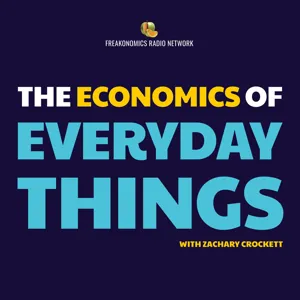Podcast Summary
Jordan Beckwith's Journey to Becoming Footless Joe: 13-year-old Jordan's tragic fall led to multiple surgeries and a life-changing decision to amputate at age 27. Despite the challenges, her resilience and determination have made her a successful YouTube personality with a million subscribers.
Jordan Beckwith's journey to becoming Footless Joe, a YouTube personality with a million subscribers, began with a tragic fall at the age of 13 that resulted in multiple surgeries and a decision to undergo a below-the-knee amputation at the age of 27. Despite the intense and expensive process of adjusting to a new prosthetic limb, which is a common experience for the over 2 million Americans living with limb loss, Jordan's resilience and determination have led her to find success and inspiration in her unique circumstances. From the quick recovery process in the hospital to the ongoing relationship with her prosthetic leg, Jordan's story highlights the challenges and triumphs of living with a limb difference.
The Importance of Trust and Intimacy between Amputees and Their Prosthetists: Finding a good prosthetist is vital for amputees as they create customized devices that significantly impact quality of life. Trust and intimacy are key in this relationship. To enter this field, obtain an MPO degree and certification.
The relationship between an amputee and their prosthetist is crucial for successful use of prosthetics. This relationship is built on trust and intimacy, as the prosthetist plays a significant role in creating customized devices that can significantly impact an amputee's quality of life. Joe Beckwith, a satisfied patient, emphasizes the importance of finding a good prosthetist, highlighting the role of Hanger Prosthetics, the largest provider in the industry, in providing prosthetics and orthotics. For those interested in this field, obtaining a master's degree in Prosthetics and Orthotics (MPO) and going through a formal certification process is necessary. Eric Neufeld, the owner and medical director of Agile Orthopedics, shares that the ability to make a difference and solve problems drew him to this field.
Prosthetics and orthotics involve long-term relationships with patients and customization: Prosthetics and orthotics are custom-made, time-consuming, and expensive, requiring extensive consultation and frequent maintenance.
Prosthetics and orthotics are more than just a one-time delivery of a device; they involve a long-term relationship with patients, frequent maintenance, and customization. These highly specialized products, which include everything from simple walking boots to complex above-knee prostheses, are considered Durable Medical Equipment (DME). The financial model for DME is based on a single item and the associated services, making it challenging for professionals like Newfeld to be compensated for their time and expertise. Creating a custom prosthetic involves extensive consultation and time-consuming processes, such as designing and fitting the socket that connects the residual limb to the prosthesis. The socket is unique to each person, and the attachment point at the bottom of it is where various components, like the knee, shin section, ankle portion, and foot, are added. The alignment of these components is crucial to ensure safety and optimal performance, as each person walks differently based on their strength and compensatory mechanisms. Given the extensive customization and consultation required, it's no surprise that prosthetic limbs can be quite expensive. A below-knee prosthesis, for example, costs around $15,000 to $20,000, with just the ankle component costing thousands on its own. Despite the financial challenges, the prosthetics field remains dedicated to providing life-changing solutions for individuals with limb loss or limb differences.
Cost of Prosthetic Components: From $30,000 to $100,000+: Advanced prosthetic components with features like microprocessors, hydraulics, and myoelectrics can cost up to $100,000, limiting accessibility and affordability for many users. Biomechatronics research aims to improve proprioception and motor control.
The cost of prosthetic components, such as ankles and knees, can be substantial, with standard mechanical devices costing around $30,000 and microprocessor-controlled devices reaching up to $100,000 or more. These costs include not only the components themselves but also the negotiation process between clinics, distributors, and manufacturers. Microprocessor-controlled components, which offer advanced stability and support, use hydraulics, rechargeable batteries, and learn the user's movements over time. Myoelectric devices, which use signals from the user's muscles to control the prosthetic, can even provide the sensation of touch. However, the more advanced features come with a higher price tag and a longer learning curve. Engineers in the field of biomechatronics are working on improving proprioception, the body's sense of where its parts are in space, to enhance motor control in prosthetic devices. Overall, the cost and complexity of prosthetic components significantly impact their accessibility and affordability.
A simple socket with a fork attachment proved functional for a woman with a lost arm: Insurance and financial barriers limit access to functional prosthetics for many patients, requiring extensive documentation and frequent out-of-pocket expenses
Sometimes the simplest solutions can be the most functional. A woman who had lost her arm above the elbow found that all she really needed was a simple socket with a fork attached to hold a carrot while cutting. However, for many patients, even basic prosthetics remain out of reach due to financial and insurance-related barriers. If a prosthetic is medically necessary, extensive documentation is required from both the prosthetist and the prescribing physician. Insurance companies consider a patient's function level, potential for rehabilitation, physical ability, life expectancy, home and work environment, and even their determination. Once approved, insurance covers 80% of the cost, but components can wear out before they're covered, leading to out-of-pocket expenses. Every three years, insurance may consider covering a new ankle, but many components can wear out much faster.
Cost and availability challenges for amputees: Amputees face significant cost and availability challenges for prosthetics, with basic liners costing $1,000 and sleeves $300-$400. Innovative solutions have emerged, but affordability may improve with advancements in 3D printing technology.
The cost and availability of prosthetics can present significant challenges for amputees, particularly in underresourced communities. A basic liner, which directly contacts the skin, costs $1,000 and lasts six months at best. Sleeves, which support sectional prosthetics, wear out every two months and cost between $300 and $400. Innovative solutions, such as upside-down soda bottles and scrap wood, have been used in resource-poor areas to create functional prosthetics. However, the number of amputees in the US is projected to double by 2050 due to rising rates of diabetes and peripheral arterial disease. Affordability may improve with advancements in 3D printing technology, which could enable the creation and distribution of custom prosthetic sockets more efficiently and cost-effectively.
Revolutionizing Prosthetics with 3D Printing and Recycling: 3D printing is making prosthetics more efficient and cost-effective, while recycling and reuse of parts addresses accessibility issues and reduces waste.
3D printing is revolutionizing the prosthetics industry by making it more efficient to create and iterate on designs. However, there are still challenges, such as creating strong enough materials for certain parts, like lakes. Another solution to the cost and accessibility issue is the recycling and reuse of prosthetic parts. Organizations like the one founded by Eric Neufeld are collecting and distributing recycled componentry to manufacturing facilities and labs in countries like Guatemala and Ecuador. This not only reduces waste but also helps change lives by providing affordable prosthetic solutions. Joe Beckwith, a YouTube content creator who shares her journey as an amputee, emphasizes the importance of figuring out what you want in life and adapting to it. Through her experiences and community, she considers herself lucky. It's important to remember that not all injuries or disabilities come from military backgrounds or dramatic events. The Freakonomics Radio Network's Economics of Everyday Things episode on prosthetics highlights these innovations and the impact they have on individuals and communities.





